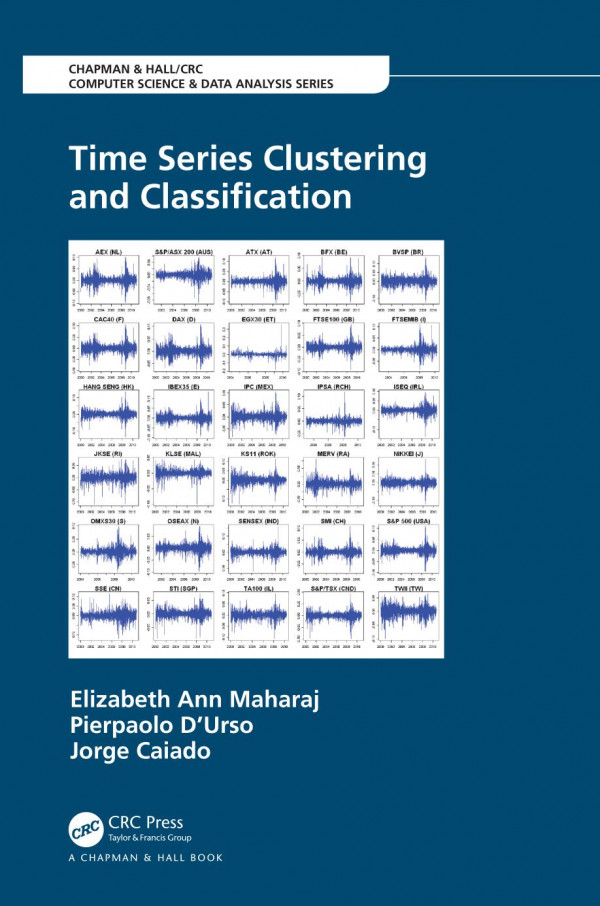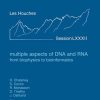(Ebook PDF) Time Series Clustering and Classification 1st Edition by Elizabeth Ann Maharaj, Pierpaolo D Urso, Jorge Caiado ISBN 9780429603303 0429603304 full chapters
$50.00 Original price was: $50.00.$35.00Current price is: $35.00.
Time Series Clustering and Classification 1st Edition Elizabeth Ann Maharaj (Author) Digital Instant Download
Author(s): Elizabeth Ann Maharaj (Author); Pierpaolo D`Urso (Author); Jorge Caiado (Author)
ISBN(s): 9781498773225, 0429195338
Edition: 1
File Details: PDF, 4.53 MB
Year: 2019
Language: english
SKU: EB-11911610
Category: Science (General)
Tags: Elizabeth Ann Maharaj (Author), Jorge Caiado (Author), Pierpaolo D`Urso (Author)
Time Series Clustering and Classification 1st Edition by Elizabeth Ann Maharaj, Pierpaolo D Urso, Jorge Caiado -Ebook PDF Instant Download/Delivery:9780429603303, 0429603304
Instant download Full Chapter of Time Series Clustering and Classification 1st Edition after payment

Product details:
ISBN 10:0429603304
ISBN 13:9780429603303
Author: Elizabeth Ann Maharaj, Pierpaolo D’Urso, Jorge Caiado
The beginning of the age of artificial intelligence and machine learning has created new challenges and opportunities for data analysts, statisticians, mathematicians, econometricians, computer scientists and many others. At the root of these techniques are algorithms and methods for clustering and classifying different types of large datasets, including time series data. Time Series Clustering and Classification includes relevant developments on observation-based, feature-based and model-based traditional and fuzzy clustering methods, feature-based and model-based classification methods, and machine learning methods. It presents a broad and self-contained overview of techniques for both researchers and students. Features Provides an overview of the methods and applications of pattern recognition of time series Covers a wide range of techniques, including unsupervised and supervised approaches Includes a range of real examples from medicine, finance, environmental science, and more R and MATLAB code, and relevant data sets are available on a supplementary website
Table of Contents:
- 1. Introduction
- 1.1 Overview
- 1.2 Examples
- 1.3 Structure of the book
- 2. Time series features and models
- 2.1 Introduction
- 2.2 Stochastic processes
- 2.3 Autocorrelation and partial autocorrelation functions
- 2.4 Time series models
- 2.4.1 Stationary models
- 2.4.2 Non-stationary models
- 2.4.3 Some other models
- 2.5 Spectral representation of time series
- 2.5.1 Periodogram
- 2.5.2 Smoothed periodogram
- 2.6 Wavelet representation of time series
- 2.6.1 Discrete wavelet transform (DWT)
- 2.6.2 Modified discrete wavelet transform (MODWT)
- 2.6.3 Wavelet variance
- 2.6.4 Wavelet correlation
- 2.7 Conclusion
- Part I: Unsupervised Approaches: Clustering Techniques for Time Series
- 3. Traditional cluster analysis
- 3.1 Introduction
- 3.2 Distance measures
- 3.3 Hierarchical clustering
- 3.4 Non-hierarchical clustering (partitioning clustering)
- 3.4.1 c-Means clustering method
- 3.4.2 c-Medoids clustering method
- 3.5 Some cluster validity criteria
- 3.5.1 Calinski and Harabasz criterion
- 3.5.2 Silhouette criterion
- 4. Fuzzy clustering
- 4.1 Introduction
- 4.2 Fuzzy c-Means (FcM) clustering
- 4.3 Cluster validity criteria
- 4.3.1 Criteria based on partition coefficient and partition entropy
- 4.3.2 The Xie-Beni criterion
- 4.3.3 The Silhouette criterion
- 4.4 Fuzzy c-Medoids (FcMd) clustering
- 4.5 Fuzzy clustering with entropy regularization
- 4.6 Robust fuzzy clustering
- 4.6.1 Fuzzy clustering with noise cluster
- 4.6.2 Fuzzy clustering with exponential distance
- 4.6.3 Trimmed fuzzy clustering
- 5. Observation-based clustering
- 5.1 Introduction
- 5.2 Observation-based distance measures
- 5.2.1 Dynamic time warping
- 5.3 Clustering methods
- 6. Feature-based clustering
- 6.1 Introduction
- 6.2 Time domain features – Autocorrelations and partial autocorrelations
- 6.2.1 Crisp clustering methods
- 6.2.2 Fuzzy clustering methods
- 6.3 Time domain features – Quantile autocovariances
- 6.3.1 QAF-based fuzzy c-medoids clustering model (QAF–FcMdC model)
- 6.4 Time domain features – Variance ratios
- 6.4.1 Variance ratio tests
- 6.4.2 Variance ratio-based metric
- 6.5 Other time domain clustering methods
- 6.6 Frequency domain features – Spectral ordinates
- 6.6.1 Crisp clustering methods
- 6.6.2 Fuzzy clustering methods
- 6.7 Frequency domain clustering methods for time series of unequal lengths
- 6.7.1 Hypothesis testing
- 6.7.2 Comparison of processes with similar sample characteristics with simulated time series
- 6.7.3 Clustering ARMA and ARIMA processes with simulated time series of unequal lengths
- 6.8 Other frequency domain clustering methods
- 6.9 Wavelet-based features
- 6.10 Other feature-based applications
- 6.10.1 Comparison between trend-stationary and difference-stationary processes
- 6.10.2 Comparison of processes with different characteristics of persistence
- 7. Model-based clustering
- 7.1 Introduction
- 7.2 Autoregressive expansions
- 7.2.1 AR(1) and MA(1) coefficients-based distances
- 7.2.2 AR coefficients-based distance
- 7.2.3 ARMA(p,q) coefficents-based distance
- 7.3 Fitted residuals
- 7.4 Forecast densities
- 7.4.1 Clustering based on forecast densities
- 7.4.2 Clustering based on the polarization of forecast densities
- 7.5 ARMA mixture models
- 7.6 Generalized autoregressive conditional heteroskedasticity (GARCH) models
- 7.6.1 Unconditional, Minimum and Time-varying Volatilities
- 7.6.2 A GARCH-based metric for time series clustering
- 7.6.3 A combined distance measure for heteroskedastic time series
- 7.6.4 GARCH-based Fuzzy c-Medoids Clustering model (GARCH-FcMdC)
- 7.6.5 GARCH-based Exponential Fuzzy c-Medoids Clustering model (GARCH-E-FcMdC)
- 7.6.6 GARCH-based Fuzzy c-Medoids Clustering with Noise Cluster model (GARCH-NC-FcMdC)
- 7.6.7 GARCH-based Trimmed Fuzzy c-Medoids Clustering model (GARCH-Tr-FcMdC)
- 7.7 Generalized extreme value distributions
- 7.8 Other model-based approaches
- 8. Other time series clustering approaches
- 8.1 Introduction
- 8.2 Hidden Markov Models
- 8.3 Support vector clustering
- 8.4 Self-Organising Maps
- 8.4.1 Wavelet-based Self-Organizing Map (W-SOM)
- 8.5 Other data mining algorithms
- Part II: Supervised Approaches: Classification Techniques for Time Series
- 9. Feature-based approaches
- 9.1 Introduction
- 9.2 Discriminant Analysis
- 9.3 Frequency domain approaches
- 9.4 Wavelet feature approaches
- 9.4.1 Classification using wavelet variances
- 9.4.2 Classification using wavelet variances and correlations
- 9.4.3 Classification using evolutionary wavelet spectra
- 9.5 Time-domain approaches
- 9.5.1 Classification using shapes
- 9.5.2 Classification using complex demodulation
- 10. Other time series classification approaches
- 10.1 Introduction
- 10.2 Classification trees
- 10.3 Gaussian mixture models
- 10.4 Bayesian approach
- 10.5 Nearest neighbours methods
- 10.6 Support vector machines
- Part III: Software and Data Sets
- 11. Software and data sets
- 11.1 Introduction
- 11.2 Chapter 5 Application
- 11.2.1 Application 5.1
- 11.3 Chapter 6 Applications
- 11.3.1 Application 6.1
- 11.3.2 Application 6.2
- 11.3.3 Application 6.3
- 11.3.4 Application 6.4
- 11.3.5 Application 6.5
- 11.3.6 Application 6.6
- 11.3.7 Application 6.7
- 11.3.8 Application 6.8
- 11.4 Chapter 7 Applications
- 11.4.1 Application 7.1
- 11.4.2 Application 7.2
- 11.4.3 Application 7.3
- 11.5 Chapter 8 Application
- 11.5.1 Application 8.1
- 11.6 Chapter 9 Applications
- 11.6.1 Application 9.1
- 11.6.2 Application 9.2
- 11.6.3 Application 9.3
- 11.7 Software packages
People also search:
time series clustering and classification
time series clustering algorithms
time series clustering example
time series cluster analysis
time series clustering and classification book
Tags:
Elizabeth Ann Maharaj,Pierpaolo D Urso,Jorge Caiado,Time Series Clustering,Classification

